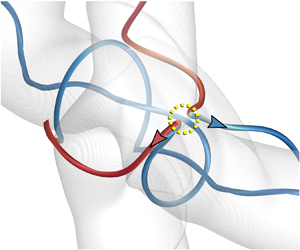Article contents
Magnetic knot cascade via the stepwise reconnection of helical flux tubes
Published online by Cambridge University Press: 18 February 2021
Abstract

We report a knot cascade of magnetic field lines through the stepwise reconnection of a pair of orthogonal helical flux tubes with opposite chirality. The magnetic-surface field is developed to identify the evolution of flux tubes and pinpoint the reconnection region. We find that the incipient X-type magnetic reconnection generates antiparallel U-shaped field lines moving in opposite directions away from the plasmoid. This reconnection is characterized by the decay of the magnetic flux through the diagonal symmetric planes. Subsequently, overhand magnetic knots are tied via the secondary reconnection, coinciding with the notable conversion from magnetic energy to kinetic energy. The knotted field lines are then rotated and stretched in the plasmoid by the vortical-like local motion induced by the magnetic knots themselves via the Lorentz force. This nonlinear evolution triggers the tertiary reconnection to form double overhand knots, and then further reconnections to produce more complex knots. From field lines extracted at different times, the knot cascade via the sequence of reconnections in a finite time period is quantified by the increment of the minimum crossing number and the migration of the probability density function of the Alexander–Briggs notation. Finally, the knot cascade slows down and then terminates due to resistive and viscous dissipations.
- Type
- JFM Papers
- Information
- Copyright
- © The Author(s), 2021. Published by Cambridge University Press
References
REFERENCES
- 3
- Cited by





